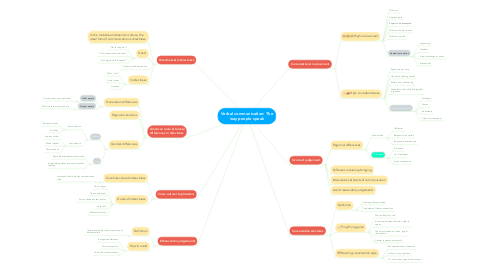
1. Directness & Indirectness
1.1. In the mainstream American culture, the ideal form of communication is directness.
1.2. Direct
1.2.1. "Get to the point!"
1.2.2. "Don't beat around the bush!"
1.2.3. "Let's get down to business!"
1.3. "Honesty is the best policy"
1.4. Indirectness
1.4.1. "Talk in circle"
1.4.2. Avoid issues
1.4.3. Hesitate
2. American male & female differences in directness
2.1. Generation differences
2.1.1. Older people
2.1.1.1. Communicate more traditional
2.1.2. Younger people
2.1.2.1. Communicate more modernly
2.2. Regional variations
2.3. Gender differences
2.3.1. Women
2.3.1.1. More direct in
2.3.1.1.1. Emotional issues
2.3.1.1.2. Feelings
2.3.1.2. Less direct in
2.3.1.2.1. Express critism
2.3.1.2.2. Make request
2.3.1.2.3. Offer opinions
2.3.2. Men
2.3.2.1. Share ideas & expressions directly
2.3.2.2. Avoid talking about emotional issues & feelings
3. Cross-cultural implications
3.1. Countries valued indirectness
3.1.1. Americans should modify communication style
3.2. Goals of indirectness
3.2.1. Do not anger
3.2.2. Do not embarrass
3.2.3. Do not shame another person
3.2.4. Save face
3.2.5. Maintain harmony
4. Ethnocentric judgements
4.1. Definition
4.1.1. Understanding the ideas or practices of another culture
4.2. How to avoid
4.2.1. Recognize differences
4.2.2. Avoid assumption
4.2.3. Learn about other cultures
5. Conversational involvement
5.1. High involvement
5.1.1. Talk more
5.1.2. Interrupt more
5.1.3. Expect to be interrupted
5.1.4. Talk more loudly at times
5.1.5. Talk more quickly
5.1.6. Heated conversation
5.1.6.1. Arguements
5.1.6.2. Loudness
5.1.6.3. A rapid exchange of words
5.1.6.4. Interruptions
5.2. High considerateness
5.2.1. Speak one at a time
5.2.2. Use polite listening sounds
5.2.3. Refrain from interrupting
5.2.4. Give plenty of positive & respectful responses
5.2.5. Hesitant conversation
5.2.5.1. Politeness
5.2.5.2. Pauses
5.2.5.3. Indirectness
5.2.5.4. A lack of interruptions
6. Incorrect judgement
6.1. Regional differences
6.1.1. New Yorkers
6.1.1.1. Talk faster
6.1.1.2. Respond more quickly
6.1.1.3. Be pushy & domineering
6.1.2. Californians
6.1.2.1. Be slower
6.1.2.2. Less intelligent
6.1.2.3. Not as responsive
6.2. Different cultural upbringing
6.3. Mannerisms & habits of communication
6.4. Avoid reasonable judgements
7. Conversation stuctures
7.1. Definition
7.1.1. The way people converse
7.1.2. The pattern of their conversations
7.2. Ping Pong game
7.2.1. Wait politely for a turn
7.2.2. Know exactly when the time is right to speak
7.2.3. Their turn depend on status, age & relationship
7.2.4. Answer to questions carefully
7.3. Bowling conversation style
7.3.1. Monopolize the conversation
7.3.2. Ask too many questions
7.3.3. Do not have enough time to answer

